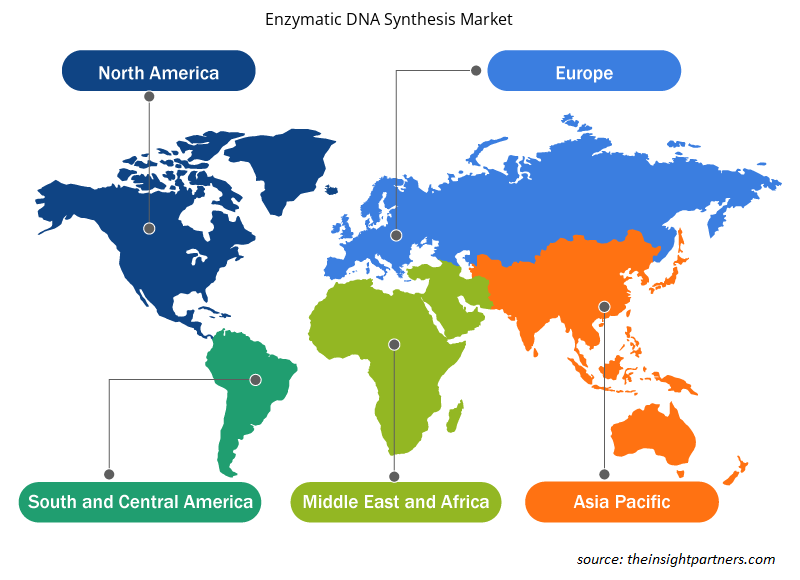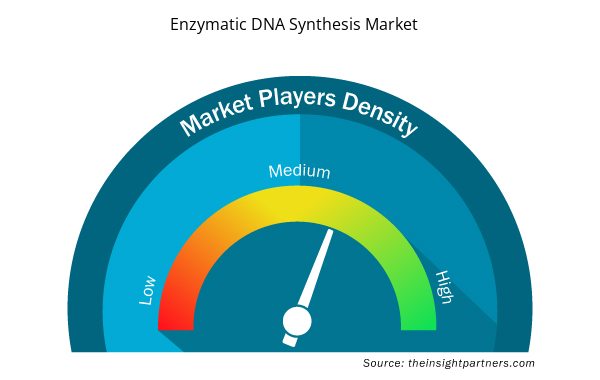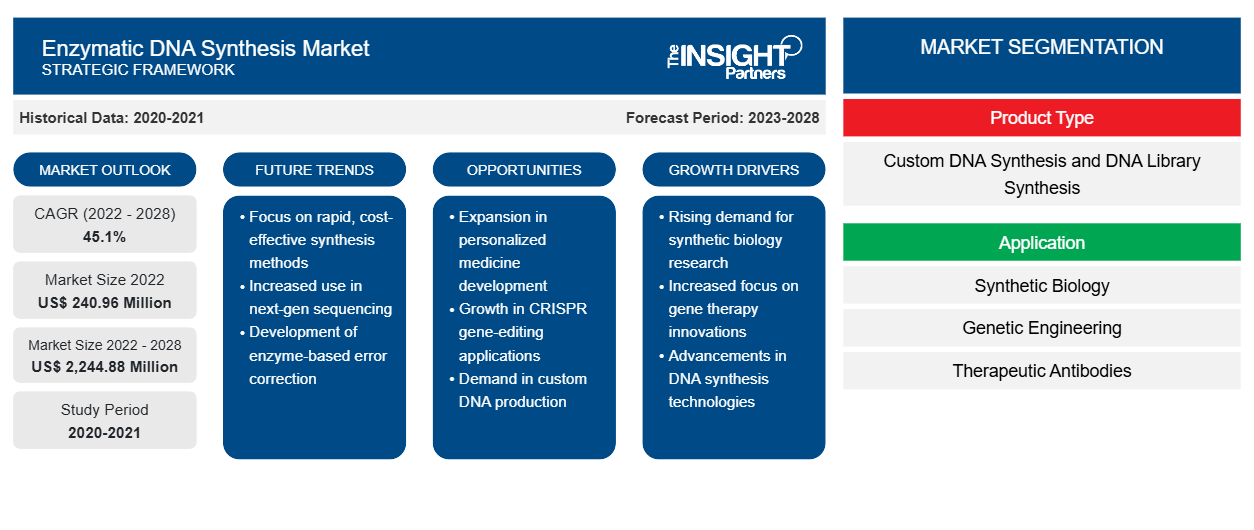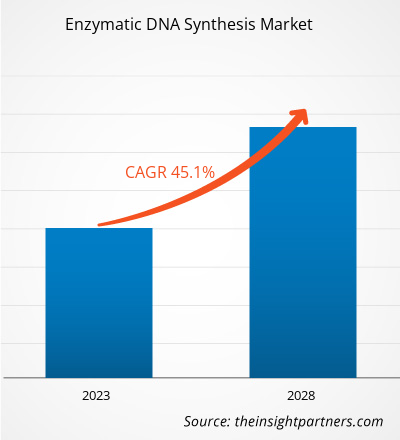[Informe de investigación] Se espera que el mercado de síntesis enzimática de ADN crezca de 240,96 millones de dólares estadounidenses en 2022 a 2244,88 millones de dólares estadounidenses en 2028; se estima que registrará una CAGR del 45,1% entre 2022 y 2028.
La síntesis enzimática de ADN es una técnica de síntesis de ADN bien establecida que resulta útil en biología sintética, ingeniería genética, producción de anticuerpos terapéuticos, diseño de vacunas y otros procedimientos biológicos avanzados. También ha demostrado ser útil para mantener bibliotecas de ADN y sintetizar moléculas de ADN personalizadas.
Perspectivas del mercado de síntesis enzimática de ADN
La creciente prevalencia de trastornos genéticos impulsa el crecimiento del mercado de síntesis enzimática de ADN
El síndrome de Down, el trastorno del espectro autista, el cáncer, la diabetes, la fibrosis quística y la anemia de células falciformes son algunos de los trastornos genéticos más conocidos. Según Global Genes, se han identificado más de 10 000 enfermedades genéticas y raras diferentes, y aproximadamente 400 millones de personas padecen enfermedades raras. Algunos trastornos genéticos causan síntomas al nacer, mientras que otros se desarrollan con el tiempo. La carga mundial de enfermedades genéticas parece estar aumentando. Según el Centro Nacional de Información Biotecnológica (NCBI), una organización médica con sede en EE. UU., en noviembre de 2021, se identificaron trastornos genéticos en el 9,4 % de los pacientes pediátricos, y el 44,7 % eran recién nacidos gravemente enfermos. Además, 13,17 millones de pacientes en EE. UU. padecen trastornos genéticos únicos. Según el informe de 2022 de los Centros para el Control y la Prevención de Enfermedades (CDC), la anemia de células falciformes afecta a aproximadamente 100 000 estadounidenses y se presenta en 1 de cada 356 nacimientos de afroamericanos. La fibrosis quística, otra enfermedad genética común en todo el mundo, afecta a unas 30.000 personas en los EE. UU. y se tratan unos 1.000 casos nuevos al año. La síntesis enzimática de ADN es una técnica de síntesis de ADN bien establecida que resulta útil en biología sintética, ingeniería genética y estudios de anticuerpos terapéuticos. Junto con los ensayos enzimáticos, la síntesis de ADN muestra mayores posibilidades de diagnóstico. Este método proporciona información importante sobre las personas en riesgo y les ayuda a tomar decisiones importantes con respecto al diagnóstico de la enfermedad y la medicación. Por lo tanto, con la creciente prevalencia de trastornos genéticos en todo el mundo, las personas se están volviendo más conscientes de la necesidad de la detección temprana de estos defectos genéticos, lo que impulsa el crecimiento del mercado de la síntesis enzimática de ADN.
Personalice este informe según sus necesidades
Obtendrá personalización en cualquier informe, sin cargo, incluidas partes de este informe o análisis a nivel de país, paquete de datos de Excel, así como también grandes ofertas y descuentos para empresas emergentes y universidades.
- Obtenga las principales tendencias clave del mercado de este informe.Esta muestra GRATUITA incluirá análisis de datos, desde tendencias del mercado hasta estimaciones y pronósticos.
Los altos costos y los procedimientos complejos obstaculizan el crecimiento del mercado de síntesis enzimática de ADN
Las técnicas de síntesis enzimática de ADN no están lo suficientemente maduras y se requiere una mayor optimización antes de que se implementen para un uso generalizado. La mayoría se basan en la enzima natural desoxinucleotidil transferasa terminal (TdT), que se utiliza en sistemas biológicos para agregar nuevas bases a una secuencia de ADN. El método basado en TdT es mejor que el procedimiento químico, ya que evita la producción de desechos peligrosos. Sin embargo, los altos costos y la baja precisión de esta enzima dificultan su uso en la síntesis de ADN in vitro. La enzima TdT es demasiado permisiva y agrega bases incorrectas con más frecuencia de lo que debería. Como resultado, los oligos basados en TdT tienen más errores de secuencia y pueden requerir los mismos pasos de control de calidad posteriores a la síntesis, o incluso más, lo que aumenta el tiempo y el costo del proceso de síntesis. Mientras trabajan con esta enzima, los científicos necesitan agregar más reactivos para construir su secuencia objetivo, lo que aumenta aún más el costo de todo el proceso de síntesis. El costo por base de ADN sintético obtenido mediante TdT es mucho más alto que el de los materiales genéticos sintetizados de manera convencional. Por tanto, los elevados costes y los procedimientos complejos limitan el crecimiento del mercado de síntesis enzimática de ADN.deoxynucleotidyl transferase (TdT), which is used in biological systems to add new bases to a DNA sequence. TdT-based method is an improved one over the chemical procedure as it avoids the production of hazardous waste. However, the high costs and low accuracy of this enzyme hinder its use in in vitro DNA synthesis. The TdT enzyme is too permissive, adding wrong bases more often than it should. As a result, TdT-based oligos have more sequence errors and may require the same or even more post-synthesis quality control steps, increasing the time and cost of the synthesis process. While working with this enzyme, scientists need to add more reagents to build their target sequence, which further adds to the cost of the entire synthesis process. The cost per base of synthetic DNA obtained using TdT is much high than conventionally synthesized genetic materials. Thus, high costs and complex procedures limit the growth of the enzymatic DNA synthesis market.
Información basada en el tipo de producto
Según el tipo de producto, el mercado de síntesis enzimática de ADN se segmenta en síntesis de ADN personalizada y síntesis de bibliotecas de ADN. El segmento de síntesis de bibliotecas de ADN tuvo la mayor participación de mercado en 2021. Además, se prevé que el segmento de síntesis de ADN personalizada registre la CAGR más alta durante el período de pronóstico (2022-2028).
Perspectivas basadas en aplicaciones
Según la aplicación, el mercado de síntesis enzimática de ADN se segmenta en biología sintética , ingeniería genética , anticuerpos terapéuticos, diseño de vacunas y otras aplicaciones. El segmento de biología sintética tuvo la mayor participación del mercado en 2021. Se espera que el mercado de síntesis enzimática de ADN para la aplicación de anticuerpos terapéuticos crezca a la CAGR más alta durante el período de pronóstico.
Información basada en el usuario final
Según el usuario final, el mercado de síntesis enzimática de ADN se segmenta en institutos académicos y de investigación, empresas biotecnológicas y farmacéuticas, laboratorios de diagnóstico y otros. El segmento de empresas biotecnológicas y farmacéuticas tuvo la mayor participación del mercado en 2021. Se prevé que el segmento de institutos académicos y de investigación registre la CAGR más alta del mercado durante el período de pronóstico (2022-2028).
Perspectivas regionales del mercado de síntesis enzimática de ADN
Los analistas de Insight Partners han explicado detalladamente las tendencias y los factores regionales que influyen en el mercado de síntesis enzimática de ADN durante el período de pronóstico. Esta sección también analiza los segmentos y la geografía del mercado de síntesis enzimática de ADN en América del Norte, Europa, Asia Pacífico, Oriente Medio y África, y América del Sur y Central.

- Obtenga datos regionales específicos para el mercado de síntesis enzimática de ADN
Alcance del informe de mercado de síntesis enzimática de ADN
| Atributo del informe | Detalles |
|---|---|
| Tamaño del mercado en 2022 | US$ 240,96 millones |
| Tamaño del mercado en 2028 | US$ 2.244,88 millones |
| CAGR global (2022-2028) | 45,1% |
| Datos históricos | 2020-2021 |
| Período de pronóstico | 2023-2028 |
| Segmentos cubiertos | Por tipo de producto
|
| Regiones y países cubiertos | América del norte
|
| Líderes del mercado y perfiles de empresas clave |
|
Densidad de actores del mercado de síntesis enzimática de ADN: comprensión de su impacto en la dinámica empresarial
El mercado de síntesis enzimática de ADN está creciendo rápidamente, impulsado por la creciente demanda de los usuarios finales debido a factores como la evolución de las preferencias de los consumidores, los avances tecnológicos y una mayor conciencia de los beneficios del producto. A medida que aumenta la demanda, las empresas amplían sus ofertas, innovan para satisfacer las necesidades de los consumidores y aprovechan las tendencias emergentes, lo que impulsa aún más el crecimiento del mercado.
La densidad de actores del mercado se refiere a la distribución de las empresas o firmas que operan dentro de un mercado o industria en particular. Indica cuántos competidores (actores del mercado) están presentes en un espacio de mercado determinado en relación con su tamaño o valor total de mercado.
Las principales empresas que operan en el mercado de síntesis enzimática de ADN son:
- Telesis Bio Inc
- Evonetix
- Ansa Biotecnologías, Inc.
- Biografía de Camena
- Corporación GenScript Biotech.
Descargo de responsabilidad : Las empresas enumeradas anteriormente no están clasificadas en ningún orden particular.

- Obtenga una descripción general de los principales actores clave del mercado de síntesis enzimática de ADN
Perspectivas basadas en la tecnología
Según la tecnología, el mercado de síntesis enzimática de ADN se segmenta en SOLA, CRISPR, PCR y otros. El segmento PCR tiene la mayor participación en 2021 y se espera que continúe con una tendencia similar durante el período de pronóstico. Por otro lado, se espera que el segmento CRISPR sea testigo de la CAGR más alta durante el período de pronóstico.
Estrategias que adoptan de forma destacada las empresas en el mercado de la síntesis enzimática de ADN: fusiones y adquisiciones. A continuación, se enumeran algunos desarrollos recientes de los principales actores del mercado:
- En abril de 2022, GenScript lanzó el primer chip semiconductor de mayor rendimiento de la industria para la síntesis de ADN en la conferencia mundial anual Built With Biology. Desarrollado con la tecnología de chips semiconductores en miniatura patentada por GenScript, este chip de síntesis de ADN de alta densidad permite la síntesis de 8,4 millones de oligos únicos de forma simultánea.
- En abril de 2022, Evonetix Ltd obtuvo la patente EP3551331B1 por su tecnología patentada de control térmico para la síntesis de ADN y el diseño y fabricación de sus chips de silicio en Europa. Además de ampliar la cartera de propiedad intelectual de Evonetix, la patente se percibe como un paso clave en la estrategia de la empresa para desarrollar una plataforma de síntesis de ADN de sobremesa.
- En marzo de 2022, Molecular Assemblies, Inc. recaudó 25,8 millones de dólares en financiación de Serie B con la participación de un nuevo inversor, Casdin Capital, junto con todos los principales inversores de Serie A: Agilent Technologies, iSelect Fund, Codexis, LYFE Capital y Argonautic Ventures. La empresa tiene la intención de utilizar los ingresos de la financiación para iniciar un programa de clientes clave y hacer avanzar la tecnología patentada de síntesis de ADN totalmente enzimática de la empresa hacia una comercialización temprana.
- En noviembre de 2021, DNA Script recibió una subvención de 2,2 millones de dólares del Instituto Nacional de Investigación del Genoma Humano (NHGRI) de los Institutos Nacionales de Salud (NIH) para apoyar el desarrollo de impresoras de próxima generación capaces de realizar la impresión enzimática de ADN y ARN sintéticos.
Perfiles de empresas
- Telesis Bio Inc
- Evonetix
- Ansa Biotecnologías, Inc.
- Biografía de Camena
- Corporación GenScript Biotech.
- Ensamblaje molecular
- Guión de ADN
- Luz táctil
- Tecnologías de biología sintética
- Biociencia Twist
- Análisis histórico (2 años), año base, pronóstico (7 años) con CAGR
- Análisis PEST y FODA
- Tamaño del mercado Valor/volumen: global, regional, nacional
- Industria y panorama competitivo
- Conjunto de datos de Excel



Report Coverage
Revenue forecast, Company Analysis, Industry landscape, Growth factors, and Trends

Segment Covered
This text is related
to segments covered.

Regional Scope
North America, Europe, Asia Pacific, Middle East & Africa, South & Central America

Country Scope
This text is related
to country scope.
Preguntas frecuentes
Enzymatic DNA synthesis (EDS) offers significant advantages in terms of accessibility and convenience, changing the pace and control of iteration and innovation with less environmental impact. The enzymes involved in DNA replication act coordinated to synthesize both leading and lagging strands of DNA simultaneously at the replication fork. Purported benefits of enzymatic synthesis include the ability to avoid the use of harsh chemical substances (which often result in toxic waste) and an ever-increasing ability to produce longer and longer strands of DNA, which in turn not only leads to a "more green" form of DNA synthesis, but also some incredibly powerful new uses for the longer DNA chains (e.g., vaccines, therapeutics, and data storage).
The factors that are driving the growth of the enzymatic DNA synthesis market are the rising prevalence of genetic disorders and surging number of product launches. Also, the growing demand for enzymatic DNA synthesis procedures is expected to provide opportunity for the enzymatic DNA synthesis market in forecasted period.
The enzymatic DNA synthesis market majorly consists of the players, such as Telesis Bio Inc, Evonetix, Ansa Biotechnologies, Inc., Camena Bio, GenScript Biotech Corp., Molecular Assemblie, DNA Script, Touchlight, Synbio Technologies, and Twist Bioscience.
The enzymatic DNA synthesis market is estimated to be valued at US$ 240.96 million in 2022.
The CAGR value of the enzymatic DNA synthesis market during the forecasted period of 2022-2028 is 45.1%.
The Asia Pacific region is expected to be the fastest-growing region in the enzymatic DNA synthesis market over the forecast period due to increasing government investment to provide healthcare facilities, growing advancements in healthcare infrastructure, greater adoption of advanced technologies, and rising healthcare spending in countries such as China, Japan, and India.
The enzymatic DNA synthesis market is expected to be valued at US$ 2,244.88 million in 2028.
The DNA library synthesis segment held the largest share of the market in 2022, owing to the various advantages offered by DNA library synthesis such as systematic, unbiased investigations such as high-throughput screening for discovery biology, directed evolution for protein engineering, and in vitro molecular optimization to generate mutant proteins with improved or novel properties. However, the custom DNA synthesis segment is estimated to register the highest CAGR in the market during the forecast period.
Trends and growth analysis reports related to Life Sciences : READ MORE..
The List of Companies - Enzymatic DNA Synthesis Market
- Telesis Bio Inc
- Evonetix
- Ansa Biotechnologies, Inc.
- Camena Bio
- GenScript Biotech Corp.
- Molecular Assemblies
- DNA Script
- Touchligh
- Synbio Technologies
- Twist Bioscience
The Insight Partners performs research in 4 major stages: Data Collection & Secondary Research, Primary Research, Data Analysis and Data Triangulation & Final Review.
- Data Collection and Secondary Research:
As a market research and consulting firm operating from a decade, we have published and advised several client across the globe. First step for any study will start with an assessment of currently available data and insights from existing reports. Further, historical and current market information is collected from Investor Presentations, Annual Reports, SEC Filings, etc., and other information related to company’s performance and market positioning are gathered from Paid Databases (Factiva, Hoovers, and Reuters) and various other publications available in public domain.
Several associations trade associates, technical forums, institutes, societies and organization are accessed to gain technical as well as market related insights through their publications such as research papers, blogs and press releases related to the studies are referred to get cues about the market. Further, white papers, journals, magazines, and other news articles published in last 3 years are scrutinized and analyzed to understand the current market trends.
- Primary Research:
The primarily interview analysis comprise of data obtained from industry participants interview and answers to survey questions gathered by in-house primary team.
For primary research, interviews are conducted with industry experts/CEOs/Marketing Managers/VPs/Subject Matter Experts from both demand and supply side to get a 360-degree view of the market. The primary team conducts several interviews based on the complexity of the markets to understand the various market trends and dynamics which makes research more credible and precise.
A typical research interview fulfils the following functions:
- Provides first-hand information on the market size, market trends, growth trends, competitive landscape, and outlook
- Validates and strengthens in-house secondary research findings
- Develops the analysis team’s expertise and market understanding
Primary research involves email interactions and telephone interviews for each market, category, segment, and sub-segment across geographies. The participants who typically take part in such a process include, but are not limited to:
- Industry participants: VPs, business development managers, market intelligence managers and national sales managers
- Outside experts: Valuation experts, research analysts and key opinion leaders specializing in the electronics and semiconductor industry.
Below is the breakup of our primary respondents by company, designation, and region:

Once we receive the confirmation from primary research sources or primary respondents, we finalize the base year market estimation and forecast the data as per the macroeconomic and microeconomic factors assessed during data collection.
- Data Analysis:
Once data is validated through both secondary as well as primary respondents, we finalize the market estimations by hypothesis formulation and factor analysis at regional and country level.
- Macro-Economic Factor Analysis:
We analyse macroeconomic indicators such the gross domestic product (GDP), increase in the demand for goods and services across industries, technological advancement, regional economic growth, governmental policies, the influence of COVID-19, PEST analysis, and other aspects. This analysis aids in setting benchmarks for various nations/regions and approximating market splits. Additionally, the general trend of the aforementioned components aid in determining the market's development possibilities.
- Country Level Data:
Various factors that are especially aligned to the country are taken into account to determine the market size for a certain area and country, including the presence of vendors, such as headquarters and offices, the country's GDP, demand patterns, and industry growth. To comprehend the market dynamics for the nation, a number of growth variables, inhibitors, application areas, and current market trends are researched. The aforementioned elements aid in determining the country's overall market's growth potential.
- Company Profile:
The “Table of Contents” is formulated by listing and analyzing more than 25 - 30 companies operating in the market ecosystem across geographies. However, we profile only 10 companies as a standard practice in our syndicate reports. These 10 companies comprise leading, emerging, and regional players. Nonetheless, our analysis is not restricted to the 10 listed companies, we also analyze other companies present in the market to develop a holistic view and understand the prevailing trends. The “Company Profiles” section in the report covers key facts, business description, products & services, financial information, SWOT analysis, and key developments. The financial information presented is extracted from the annual reports and official documents of the publicly listed companies. Upon collecting the information for the sections of respective companies, we verify them via various primary sources and then compile the data in respective company profiles. The company level information helps us in deriving the base number as well as in forecasting the market size.
- Developing Base Number:
Aggregation of sales statistics (2020-2022) and macro-economic factor, and other secondary and primary research insights are utilized to arrive at base number and related market shares for 2022. The data gaps are identified in this step and relevant market data is analyzed, collected from paid primary interviews or databases. On finalizing the base year market size, forecasts are developed on the basis of macro-economic, industry and market growth factors and company level analysis.
- Data Triangulation and Final Review:
The market findings and base year market size calculations are validated from supply as well as demand side. Demand side validations are based on macro-economic factor analysis and benchmarks for respective regions and countries. In case of supply side validations, revenues of major companies are estimated (in case not available) based on industry benchmark, approximate number of employees, product portfolio, and primary interviews revenues are gathered. Further revenue from target product/service segment is assessed to avoid overshooting of market statistics. In case of heavy deviations between supply and demand side values, all thes steps are repeated to achieve synchronization.
We follow an iterative model, wherein we share our research findings with Subject Matter Experts (SME’s) and Key Opinion Leaders (KOLs) until consensus view of the market is not formulated – this model negates any drastic deviation in the opinions of experts. Only validated and universally acceptable research findings are quoted in our reports.
We have important check points that we use to validate our research findings – which we call – data triangulation, where we validate the information, we generate from secondary sources with primary interviews and then we re-validate with our internal data bases and Subject matter experts. This comprehensive model enables us to deliver high quality, reliable data in shortest possible time.


 Obtenga una muestra gratuita de este informe
Obtenga una muestra gratuita de este informe